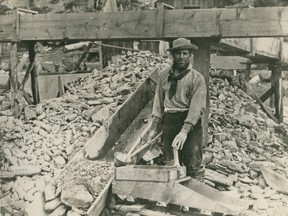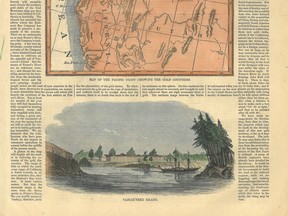Around $10 million worth of gold carried by miners on board the ill-fated Pacific could be salvaged from the wreck

Anyone with a family connection to gold on board the Pacific – a paddlewheeler that sank off the B.C. coast with the loss of at least 275 lives in 1875 – has a chance to stake their claim.
Last month, a U.S. company lodged papers in the United States District Court in Seattle stating it had located what it believes is the wreck of the Pacific at around 1,500 feet deep on the western edge of the Juan de Fuca Strait. By comparison, the Titanic sits at around 12,500 feet in the Atlantic Ocean.
Start your day with a roundup of B.C.-focused news and opinion delivered straight to your inbox at 7 a.m., Monday to Friday.
Thanks for signing up!
A welcome email is on its way. If you don't see it, please check your junk folder.
The next issue of Sunrise presented by Vancouver Sun will soon be in your inbox.
The company, Rockfish Inc., has been searching for the wreck and its golden bounty since 2006 using sonar and a towed camera sled. The search site was selected based on records from 1875 that show the ship went down southwest of Cape Flattery at the end of the Olympia Peninsular and from more recent information from commercial fishers that noted their trawling gear was getting caught up on something on the ocean floor.
According to court records, “based on the location of the wreck site, dimensions of the wreck, presence of a pair of eight metre circular objects in the debris field consistent with the dimensions of S.S. Pacific’s paddle wheels, and the presence of coal in the debris field, Rockfish believes the vessel is the wreck of the S.S. Pacific.”

The Pacific was a 225-foot wooden coal-powered sidewheeler that was built in New York in 1850 and served throughout the U.S.
The ship was partly sunk after hitting rocks in the Columbia River in 1861, but was put back into service, ending up on the Victoria to San Francisco route serving B.C.’s short-lived Cassiar Gold Rush.
On the morning of Nov. 4, 1875, the vessel departed Esquimalt in poor weather carrying at least 275 souls, including crew, paying passengers and children. Many of the passengers were gold miners taking their treasure back to San Francisco before the winter set in.
A historical paper written about the sinking states the ship was carrying “prominent Victorians, wealthy businessmen, numerous gold miners with pokes full of Cassiar gold, an equestrian troiuple and 41 Chinese labourers.
“In addition, the Pacific’s hold was laden with 2,000 sacks of oats, 300 bales of hops, 261 animal hides, 11 casks of furs, 31 barrels of cranberries, 10 cords of wood bolts, 280 tons of coal, 18 tons of general merchandise, 10 tons of sundries, six horses, two buggies, two cases of opium and a strongbox containing $79,200 in cash. The gold in private hands was estimated to be at least $100,000.”
In 1875, that represented around 4,000 ounces of gold which today would be worth close to $10 million.
At around 9:30 p.m. the sailing ship Orpheus (travelling from San Francisco to Nanaimo to collect coal) noted the lights of another ship to the right and turned left to avoid a collision.
The Pacific struck the side of the Orpheus and sank within 20 minutes. The dramatic loss of live – there were only two survivors – was due in part to to the condition of the vessel, too few lifeboats and the fact some of those lifeboats had earlier been filled with water to stop the ship listing in heavy seas.
The Orpheus did not sink, but the sinking of the Pacific remains the deadliest maritime disaster recorded in the waters off the Pacific Northwest.
Under maritime law, Rockfish has won court approval to salvage what it can from the wreckage, claiming it will be used to create a maritime museum in co-operation with the Northwest Shipwreck Alliance.
However, this was granted on the condition that the company acknowledge the law of finds, that entitles descendants of a person who carried gold on the ship to claim that gold.
The time a person has to make a claim is limited, and if the claim is granted by the court the claimant would have to pay Rockfish for recovering the gold.
An article in The Daily Mail states that anything recovered from the ship will have to be presented through the court system so that people can come forward and make their claim with proof.
dcarrigg@postmedia.com


